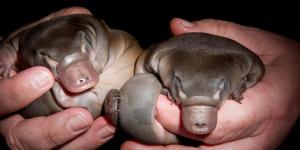Different Types of Bird Beaks


The different types of bird beaks exist largely due to the varying diet of various bird species. Such birds can be frugivorous, granivorous, insectivorous, carnivorous or even nectarivorous, as well as various omnivorous bird species. Unlike other groups of vertebrates, birds do not have teeth. Their oral cavity is made up of a beak that consists of an upper jaw and a mandible, covered by a double horny casing known as the rhamphotheca.
Although it is used to build nests, groom, communicate and defend themselves, the different beaks of birds are fundamentally used for feeding. thedailyECO explains more about these types and uses of bird beaks by providing this list with photos.
- Frugivorous bird beaks
- Granivorous bird beaks
- Insectivorous bird beaks
- Filter-feeding bird beaks
- Birds of prey beaks
- Scavenger bird beaks
- Piscivorous bird beaks
- Nectarivorous bird beaks
- Wading bird beaks
- Omnivorous bird beaks
Frugivorous bird beaks
Frugivorous birds depend on the presence of fruits to meet their nutritional requirements. They are also very important within their ecosystem since they act as seed dispersers for various plants. The shape of their beaks is very important for the type of fruit they eat. For example, they can be curved and short with sharp tips. THis is the case with the blue-fronted Amazon (Amazona aestiva) and macaws of the genus Ara which use them to break open fruit and extract its seeds.
The beaks of frugivorous birds can be very long and even be serrated, as is the case of the toco toucan (Ramphastos toco) which is seen in the photo below. Toucans have colorful and long bills which is the largest relative to size in all the animal kingdom. Not only do toucan beaks help break open various fruits, but it is believed they are also used in mating rituals to attract a prospective partner.
Take a look at other fruit-eating species with our article on types of herbivorous birds.
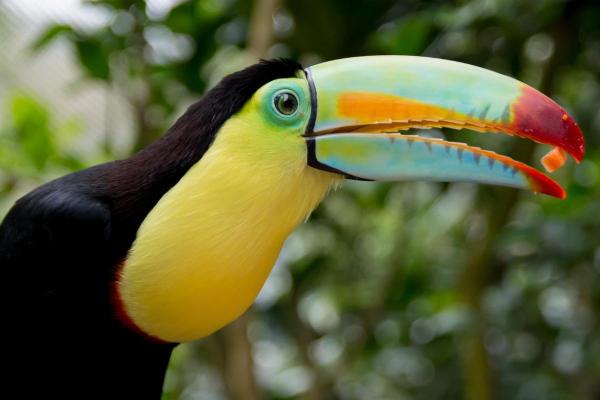
Granivorous bird beaks
Granivorous birds have a short, conical, robust and sometimes somewhat curved beak. This allows them to hold and break the hard covering of the seeds. Examples of birds that feed on seeds include the rufous-collared sparrow (Zonotrichia capensis), the red-crested cardinal (Paroaria coronata), the saffron goldfinch (Sicalis flaveola), the house sparrow (Passer domesticus), the European greenfinch (Chloris chloris) and many others.
You can see the beak of the house sparrow clearly in the photo below.

Insectivorous bird beaks
Bird species that feed mainly on insects generally have a thin and elongated beak. The masked water tyrant (Fluvicola nengeta) has a small hook at the tip of its beak that helps it catch insects. Many insectivores such as flycatchers (family Tyrannidae) and gnatcatchers (family Polioptilidae) move between trees and bushes, capturing them along the way. Striated antthrushes (Chamaeza nobilis) consume ants from the ground.
Woodpeckers and other birds are trunk insectivores. They have a powerful beak to break bark and a cranial structure that cushions blows against tree trunks. They mainly feed on ants and larvae of other insects by digging in holes. When they find them, they suck them out thanks to a sticky tongue. Other species such as the scimitar-billed woodcreeper (Drymornis bridgesii) have a very long and curved beak, which allows them to extract larvae of beetles and spiders from both tress and the ground.
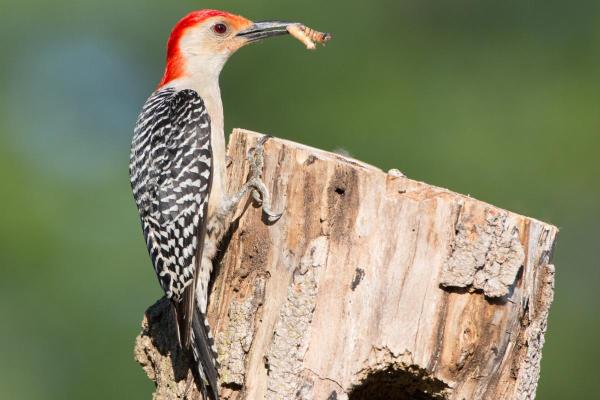
Filter-feeding bird beaks
Birds such as flamingos, spoonbills and most ducks filter microorganisms on muddy surfaces. They do so thanks to an adaptation of their bills which allows water to escape, but food to remain. Ducks (family Anatidae) have a type of bird beak that is wide, short and flattened. Flamingos (genus Phoenicopterus) have curved beak which allows them to turn their head upside down to filter the water.
Both ducks and flamingos have lamellar bills. In filter feeding, the water or mud that enters the beak comes out again through the lamellae of both jaws which interlock. Lamellae are structures that function like a sieve to keep food for eating. The photo below shows a flamingo feeding in this way.
Discover more about how flamingoes feed with our article on the different types of flamingo.
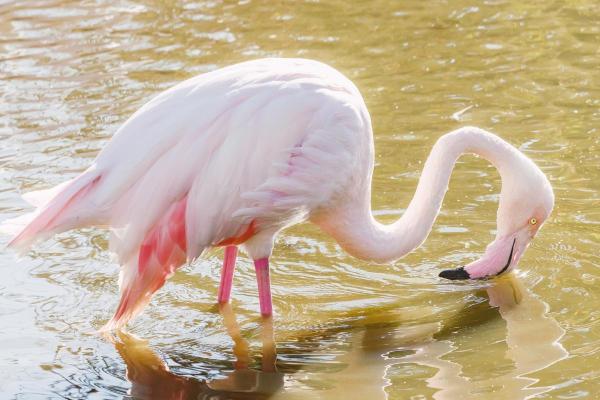
Birds of prey beaks
Also known as raptors, birds of prey have strong hooked beaks with sharp, cutting edges. They use these to both kills their prey and tear flesh when eating. The beaks of birds of prey are one of the characters used to distinguish them from other avian groups. Small birds of prey such as the American kestrel (Falco sparverius) have short beaks adapted to eating small prey, such as insects and small mammals. In contrast, the harpy eagle (Harpia harpyja) has a powerful hooked beak that allows it to tear off large pieces of meat.
There are other species with specialized diets, such as the snail kite (Rostrhamus sociabilis). They have a long and curved beak to break shell of snails which make up a large part of their diet. The osprey (Pandion haliaetus) catches its prey as it approaches the surface and uses its clawed bill to act as a fishing hook to take them out of the water.
Learn about more birds of prey types with our guide to the largest eagles in the world.
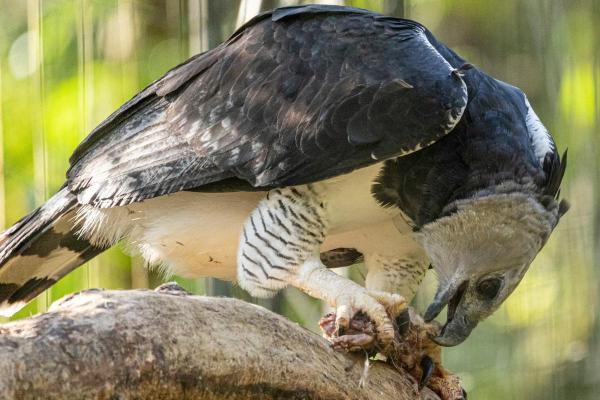
Scavenger bird beaks
Other carnivorous birds can be found in scavenger birds such as vultures and condors. These are members of the Cathartidae family which take advantage of the remains of dead animals, also known as carrion. Its beak is slightly hooked and is weaker than that of other birds of prey. This is because it is adapted to tearing meat from carrion that is already partially decomposed, as seen in the below photo.
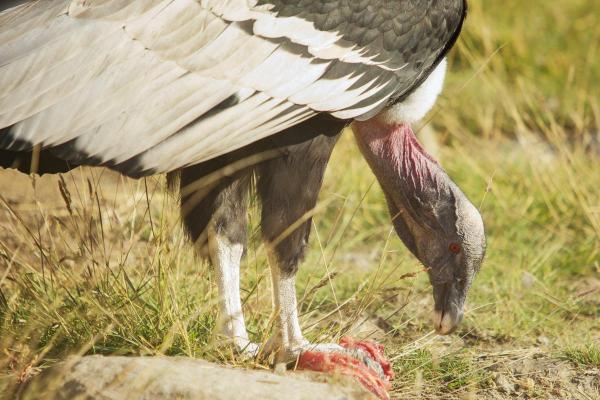
Piscivorous bird beaks
Piscivores are types of birds that feed mainly on fish, capturing them with their strong, long and sharp beaks. For example, the anhinga (Anhinga anhinga) fishes using its beak as a spear. Herons belonging to the family Ardeidae and fish with their long harpoon-like beak on the banks of waterways. Others, such as kingfishers (family Alcedinidae) track their prey and pounce on it precisely.
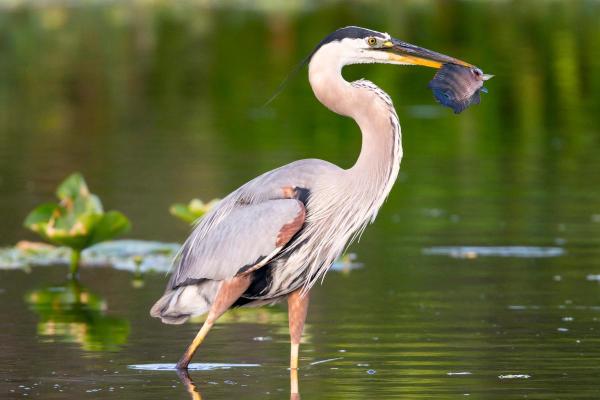
Nectarivorous bird beaks
Hummingbirds are perhaps the most well-known example of nectarivorous birds. They use their long, thin and delicate beaks to insert into various flowers. They can be curved or straight, but they use them to open up the flower to extract nectar with their tubular tongues. They are very important for pollination of the plants they visit since they transfer the pollen from the flowers to their beak and feathers.
Learn about hummingbirds and other types of pollinators with our related guide.
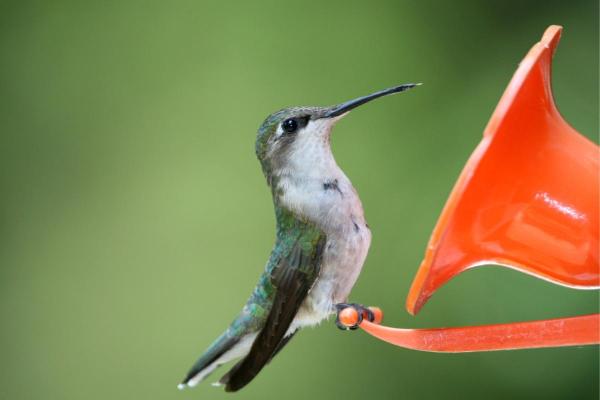
Wading bird beaks
Wading birds are those associated with wetlands and coastal regions. Their bill is usually long, thin and pointed, allowing them to scan the sand for invertebrates. Some have shorter beaks associated with a type of hunting by visual location, such as plovers of the genera Pluvialis and Charadrius.
The longer types of bills of wading birds are related to the capture of prey by tactile localization. This is due to the presence of chemoreceptors at the end of the beak. Examples of this type of bird are the Eurasian oystercatcher (Haematopus ostralegus) and the black-tailed godwit (Limosa limosa).

Omnivorous bird beaks
Omnivorous birds feed on a great diversity of food items such as fruits, seeds, plants, insects, fish and even carrion remains. For this reason, their beak is usually thick and strong so it can be adapted to many different types of food. Examples are crows of the genus Corvus, the great kiskadee (Pitangus sulphuratus), the Eurasian magpie (Pica pica) and many others.
As you can see, the different types of bills of birds help to classify these animals. Learn more with our article on how birds are classified.

If you want to read similar articles to Different Types of Bird Beaks, we recommend you visit our Facts about animals category.
- Barbosa, A. (1997). Introduction. General Characteristics of the Biology of Wading Birds.
- Bosso, A., Narosky, T. (2018). Bird watcher's manual. Ecoval Editions.
- Méndez, P., Curti, M., Herrera de Montuto, K., & Benedetti, A. (2006). Birds of prey. Environmental Education Didactic Guide. The Peregrine Fund Editorial, Panama.



